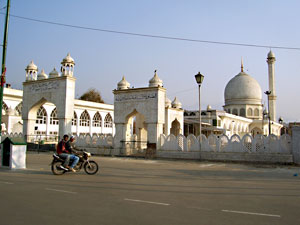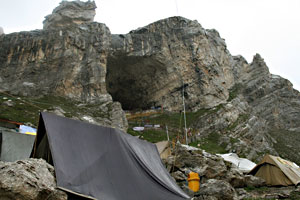|
|
|
|
Kashmir Temples and Shrines |
|
Jammu and Kashmir is like a heaven of god
for millions of people who proceed on pilgrimage to the
numerous shrines and holy sites in which the state abounds.
There is hardly any town or city in Kashmir which does not
have a shrine of its own. Some of the famous pilgrimage
shrines in Kashmir are Hazratbal Mosque, Jama Masjid,
Shankaracharya Temple, Khanqah Shah Hamadan Mosque, Makhdoom
Sahib, Chhatti Padshahi Gurudwara, Martand, Kheer Bhawani
Temple and Amarnath Cave. |
|
|
|
Hazratbal Mosque
Hazratbal Mosque is located in a village of the same
name on the banks of the Dal lake. Its pristine white
marble elegance is reflected in the waters of the lake.
Hazratbal's special significance is derived from the
fact that it houses a hair of the prophet Muhammad. This
is displayed to the public on religious occasions,
usually accompanied by fairs. Apart from these
occasions, Friday prayers are offered at Hazratbal and
attended by throngs of people. Hazratbal is remarkable
for being the only domed mosque in Srinagar; the others
having distinct pagoda like roofs. The |
 |
|
|
shrine –
mosque complex is situated on the western shore of the Dal
Lake opposite Nishat Bagh and commands a grand view of the
lake and the mountain beyond.
Jama Masjid
The Jama Masjid is the largest mosque in Kashmir. The Jama
Masjid at Nowhatta, in the heart of the old city, is the other
important mosque in Srinagar in which thousands of people
congregate for the Friday prayers. The foundation of this
mosque was laid by Sikandar in 1398 AD. This mosque was
originally built by Sultan Sikandar in 1400 AD out of wood and
bricks, and enlarged by his son, Zain-ul- Abidin. Jama Masjid
is the prominent example of the Kashmiri mosque, and
combination of Hindu, Islamic and Buddhist styles of
architecture distinguished by its tall spires. Inside, the
masjid are the frayed carpets and stone alcoves and the
40-foot high wooden columns, out of which about 300 of them
support the roof. Destroyed thrice by fire and rebuilt by
Aurangzeb in 1674, who, when he heard that fire had gutted the
mosque, first asked whether the chinars were safe. Even now,
there are chinars in the courtyard. The mosque, as it now
stands, was repaired during the reign of Maharaja Pratap
Singh. In the upper hall, there are the intricately wrought
Khatamband roof, the glint of chandeliers, the mirror-work on
the pillars and the papier-mache on the walls. In the summer
and autumn, the hall is used for weddings and dinners for
about 350 people.
Shankaracharya Temple
The Shankaracharya temple is the unique landmark of Srinagar.
The sacred temple of Shankaracharya occupies the top of the
hill known as Takht-I-Sulaiman, about 1000 feet high in the
south-east of Srinagar. The site dates back to 250 BC. The
temple is built in the memory of the philosopher
Shankaracharya who stayed at this place when he visited
Kashmir ten centuries ago to revive Sanatan Dharma. Before
this date, the temple was known as Gopadri, as an earlier
edifice on the same site was built by king Lalitaditya in the
6th century AD. Built on a high octagonal plinth and
approached by a flight of steps with side walls that once bore
inscriptions, the main temple consists of a circular cell and
is dedicated to Lord Shiva. It overlooks the Valley and can be
approached by a motorable road. A modern ceiling covers the
inner sanctum and an inscription in Persian traces its origin
to the reign of Emperor Shah Jehan. The original ceiling was
dome-shaped and the brick roof is not more than a century old. |
|
|
|
|
|
Khanqah Shah Hamadan Mosque, Srinagar
The Khanqah Shah Hamadan Mosque is situated on the banks
of the river Jhelum, between the third and fourth bridge
in Srinagar. This is the first mosque ever built in
Srinagar. The original one was built in 1395. Shah
Hamadan's full name was Mir Sayed Ali Hamadni, the
surname being derived from the city of Hamadan in
Persia. Shah-i-Hamdan, who came from Persia in the 13th
century, was responsible for the spread of Islam in
Kashmir. Khanqah-i-Mualla, on the banks of the Jhelum,
was the |
 |
|
|
very spot
where Shah-i-Hamdan used to offer prayers. This mosque is
believed to have a relic of the sacred hair of the Prophet
Mohammad. This mosque is made entirely of wood and named after
the saint who is credited with the peaceful conversion of
millions of Hindus into Islam. A mosque established by him at
Shey, near Leh attracts devotees from far and wide. The
Khanqah is a wooden structure whose chief aesthetic feature is
its beautifully carved eaves and hanging bells. The interiors
are richly carved and painted, and the antique chandeliers
give it an air of opulence. The non-Muslims are not allowed
into the mosque but they can only see the intricately painted
papier-mâché ceiling and doors.
Makhdoom Sahib
On the southern side of the Hari Parbat hill is the historic
shrine of Makhdoom Sahib, which is visited by people of all
faiths.
Chhatti Padshahi Gurudwara
The sixth Sikh guru travelled through Kashmir, stopping to
preach occasionally. A gurudwara has been built at the exact
site of each of these halts. The most important one among
these is Chhatti Padshahi gurudwara, situated near the Kathi
Darwaza, in Rainawari, Srinagar, which is held in great
reverence by devotees of all faiths.
Martand
Martand, located atop a plateau, close to the township of
Anantnag, has a temple dedicated to Surya, the "Sun God".
Built by king Laitaditya Muktapida (7th to 8th century AD), it
is a medieval temple with a colonnaded courtyard and the
shrine in its centre. The temple complex has 84 columns and
offers a commanding view of the valley of Kashmir.
Kheer Bhawani Temple
The Goddess Ragnya Devi is symbolized as a sacred spring at
Tula Mula village, 27 kms from Srinagar. Within the spring is
a small marble temple. The devotees of the goddess fast and
gather here on the eighth day of the full moon in the month of
May when, according to belief, the goddess changes the colour
of the spring's waters. The temple-spring complex is
affectionately known as Kheer Bhawani because of the thousands
of devotees who offer milk and 'kheer' to the sacred spring,
which magically turns black to warn of disaster. |
|
|
|
Amarnath Cave
The Amarnath Cave is situated about 44.8 kms. from
Pahalgam and 6 kms away from Panchtarni. It takes about
five days to reach the Amarnath Cave from Pahalgam. The
Amaranth cave is believed to be the abode of Lord Shiva.
Amarnath cave is situated on the mountains of Lidder
valley amidst iced snow at a height on 13,000 feet. The
thousands of Hindu pilgrims undertake the tour (yatra)
to the Amarnath Cave from all parts of India in the
month of Sawan (July-August) to have a glimpse of
Shivlinga |
 |
|
|
formed from
iced snow. According to the legend, the Lord Shiva narrated to
Parvati the secret of creation, in the caves of Amarnath.
Without their knowledge, a pair of mating doves eavesdropped
on their conversation and having learnt it, they were reborn
over and over again and since, have made this cave their
eternal abode. Many pilgrims have spotted these doves here.
During the month of Sawan, an ice stalagmite forms a natural
Shivlinga which waxes and wanes with the phases of the moon.
The most auspicious occasion to visit Amarnath for a
pilgrimage is on the night of the full moon in the month of
Sawan. The Amarnath yatra is done only once in the month of
July to August as it is totally cut off from the rest of the
world during winter. The dates of the yatra varies every year
due to the weather conditions and according to Purnima (Raksha
Bandhan) in the month of Sawan.
More.... |
|
